In the digital age, creating a robust online presence has become essential for businesses and individuals alike. For many, WordPress serves as the backbone of their website because of its user-friendly interface and extensive features. However, with increased accessibility comes increased vulnerability. While strong passwords are undeniably important, relying solely on them is not sufficient to ensure your WordPress site remains secure. As cyber threats evolve, so must our security strategies. This article explores the reasons why strong passwords aren’t enough and outlines advanced security measures you can implement to protect your WordPress site.
The Limitations of Strong Passwords
1. Password Theft
Even the strongest password can fall victim to theft. Methods like keylogging, phishing attacks, and social engineering techniques are commonly used by cybercriminals to steal user credentials. Once a hacker has access to your password, the entry to your website becomes alarmingly easy.
2. Brute Force Attacks
Cybercriminals often deploy brute force attack techniques, where automated software tries various combinations of passwords to gain access to your site. This makes it critical to not only have a strong password but to also implement additional security measures.
3. Credential Stuffing
With an ever-growing list of data breaches across various companies, many people reuse passwords across multiple platforms. If a password from one site is compromised, perpetrators may use the same credentials to gain access to other sites, including your WordPress blog.
4. Insider Threats
Sometimes, the breach may not come from the outside. Trusting employees, freelancers, or third-party services with your site’s credentials can unintentionally put it at risk. It’s essential to manage and control access effectively across your team.
Advanced Security Measures for WordPress
1. Two-Factor Authentication (2FA)
Implementing two-factor authentication adds an additional layer of security beyond just passwords. By requiring a second form of verification, like a code sent via SMS or a mobile authentication app, you can significantly reduce the risk of unauthorized access. Many security plugins for WordPress can easily integrate these options.
2. Regular Updates
WordPress frequently releases updates for its core software, themes, and plugins to fix security vulnerabilities. Regularly updating these components is crucial to safeguarding your website. Ignoring updates can leave your site open to exploits that have already been addressed by the community.
3. Use Security Plugins
There are several robust security plugins available that can help monitor and protect your website. Tools like Wordfence, Sucuri Security, and iThemes Security offer features such as firewall protection, malware scanning, and login attempt monitoring. Utilizing these plugins makes it challenging for potential attackers to breach your site.
4. Limit Login Attempts
By limiting the number of login attempts, you can thwart brute force attacks. Many security plugins allow you to set restrictions on how many times a user can attempt to log in before being temporarily locked out. This measure can slow down attackers hoping to gain access.
5. Secure Your Hosting Environment
Choosing a reputable web hosting provider is crucial for WordPress security. Look for hosts that offer built-in security features, daily backups, and stringent protocols to protect against potential threats. Many reputable hosts also provide support in case of a security breach, so you can recover your site with minimal downtime.
6. Implement SSL Encryption
SSL (Secure Sockets Layer) encrypts data exchanged between your website and its visitors, providing an extra layer of security. An SSL certificate enhances trustworthiness, improves your search engine ranking, and safeguards sensitive information like user login credentials and payment details.
7. Regular Backups
Even with the best security measures in place, breaches can still occur. Regularly backing up your site ensures that you can quickly restore it in case of a hack. Many plugins offer automated backup options, making the process effortless.
8. Monitor User Roles and Permissions
It’s essential to control who has access to your site and what they can do. Regularly review user roles and permissions to ensure that only the right people have access to sensitive areas of your site. Limit administrative rights to essential personnel and consider using custom roles for different user types.
9. Disable Directory Listing
Enable or disable directory listing so that if a user types in a directory URL, they won’t be able to see a list of files. This can prevent potential attackers from discovering more about your site’s structure.
Conclusion
While strong passwords are a fundamental aspect of safeguarding your WordPress site, they are far from being the be-all and end-all of security. As cyber threats become increasingly sophisticated, it’s imperative to adopt a comprehensive security strategy that integrates multiple layers of protection. By utilizing advanced security measures like two-factor authentication, regularly updating software, employing security plugins, and taking proactive steps to secure your hosting environment, you can fortify your WordPress site against potential threats. Remember, security is an ongoing process, and staying informed about best practices can help you safeguard your digital presence effectively.
Contact Us




